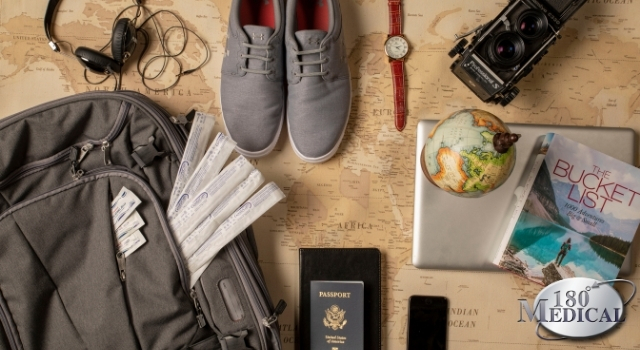What is Catheterization?
Intermittent catheterization is a way to drain urine from the bladder by placing a small tube called a catheter into the urethra to the bladder.
What Causes Someone to Need to Use Catheters?
A doctor or another qualified healthcare professional may recommend intermittent catheterization when the bladder doesn’t empty on its own.
Catheters may be prescribed due to medical conditions such as:
- Bladder retention
- Incomplete bladder emptying
- Atonic bladder
- Neurogenic Bladder
- Spinal Cord Injuries
- Multiple Sclerosis
- Brain injury or stroke
- Complications after surgery on the abdomen, bladder, prostate, or uterus
A prescribing healthcare professional may prescribe the use of intermittent catheters to keep the bladder on a regular schedule of emptying, which may help keep the bladder and kidneys healthy. In addition, this may help prevent infection while also controlling leakage.
Catheters and other catheterization supplies can be obtained with a prescription through an online medical supply store. Many health insurance plans will often cover some or even all of the cost of catheter supplies, including Medicare, state Medicaid plans, and private insurances such as Blue Cross Blue Shield, Cigna, and United Healthcare.
How Often Should I Self-Catheterize?
Your medical professional, such as a urologist, general practitioner, physician’s assistant, or nurse practitioner will prescribe a cathing schedule of how many times per day or week to self-cath. If you’re unsure, ask your prescribing healthcare professional.
Remember, just as no one catheter works for everyone across the board, no single self-catheterization schedule or regimen works for everyone either. For example, one person with severe bladder retention may have to cath 6 times per day. However, another person may only be prescribed to self-cath once a day if they experience mild incomplete bladder emptying.
When talking to your medical professional, be sure to ask questions to get specific details. There are no wrong questions. You should have a good understanding of not only how to cath but also how often to cath.
How To Perform Catheterization
It is a simple procedure that almost anyone can learn to do, even catheter users with limited hand dexterity. However, it’s understandable that many new users may have some anxiety or fears about learning to cath. No matter the reason for needing to catheterize, you can become comfortable and confident with using catheters at any age.
180 Medical has instructional booklets and DVDs for men, women, boys, and girls, and we also offer helpful online instructions for learning how to catheterize.
Self-Cathing Instructions for Women and Girls

Typically, your healthcare professional will demonstrate how to insert and use a catheter. Catheters for women can vary in French sizes (diameter). However, the average female catheter length is 6 inches long.
In order to comfortably insert a catheter, catheter users may need to keep a water-soluble catheter lubricant on-hand, depending on the catheter type. Do not use petroleum jelly such as Vaseline as this could cause blockages, irritation, and other issues.
Step 1. Preparation
To reduce the risk of urinary tract infections (UTIs), users should wash their hands well with soap and water prior to handling their catheter or catheter insertion. Next, gather any other supplies you may need for cathing, such as antiseptic cleaning wipes, disposable gloves, lubricating jelly, and/or a urine collection bag or container.
If you’re using antiseptic wipes, clean the area surrounding the urethra.
If you’re using an uncoated straight catheter, prep the catheter with lubricant by applying it to the length of the tube.
Step 2. Insertion
Without forcing the catheter, gently and slowly begin to insert the catheter tube into the urethra until urine starts to flow. If the first try is unsuccessful or painful, take a moment to relax. Then attempt to start the process over. If difficulty or pain continues, contact your healthcare provider.
Once urine begins to flow, stop inserting the catheter. Let urine flow until it stops.
Step 3. Removal and Clean-Up
Slowly remove the catheter by gently pulling the tube out by its funnel. After that, wipe once again around the urinary opening with a cleansing towelette. Then wash your hands again with soap and water.
Intermittent catheters are meant to be used once and then disposed of. If using a catheter with a full collection bag, empty it into a toilet, urinal, or another receptacle, then throw it away. Some closed system catheter kits provide a discreet, opaque disposal bag, which you may find helpful for catheterizing in public restrooms.
Catheter Instructions for Men and Boys

Catheters for men and boys come in a range of French sizes (diameter). However, the average male length catheter is around 16 inches long while pediatric catheters are typically 10 inches long.
Remember to use a sterile water-soluble catheter lubricating jelly when using an uncoated catheter.
Step 1. Preparation
Gather any necessary supplies. Some catheter-users prefer to have antiseptics towelettes, additional catheter lubrication, disposable gloves, and a collection container such as a drain bag, urinal, or nearby toilet.
Wash hands with soap and water before touching your catheter. You may also want to clean the outer urethral area with wipes before beginning.
Before insertion, depending on the catheter type being used, you may have to either activate the catheter’s hydrophilic coating or apply lubrication to the length of the catheter tube (not the handle or funnel).
Step 2. Insertion
During the insertion process, some users prefer to wear gloves. Before inserting the catheters, doctors typically recommend that users hold their penis straight out or at a very slight upward angle to help guide the catheter more easily through the urethra. You may have to try a few times with your doctor’s guidance to figure out the best angle and method of insertion for your unique anatomy and needs.
Then, with the other hand, begin to gently and slowly insert the catheter tube insertion-tip first into the urethra. If insertion feels painful or uncomfortable, stop applying pressure immediately. Take a moment to relax and do some deep breathing exercises before trying again.
Remember to never force your catheter. If you’re encountering resistance or pain that doesn’t let up even after taking a few minutes to breathe deeply and relax, contact your doctor.
Once urine begins to flow, you can insert it another few millimeters or leave the catheter where it is if urine is flowing efficiently. Let urine flow until it’s completely done before removing the intermittent catheter.
Step 3. Removal and Clean-Up
After the urine has stopped draining into a collection container or the toilet, you can begin to slowly remove the catheter. You may want to pinch the funnel of the catheter to avoid unnecessary spills if it’s not connected to a drain bag. Removing it at a slow speed helps prevent friction inside the urethra.
After removing the catheter, clean the area around the urethral opening again and wash your hands.
At first, the penis may feel irritated after self-catheterization. Remember that using plenty of lube will help with urethral friction. Also, drinking water and staying hydrated may help flush the bladder and remove any lubrication still present.
3 Most Common Mistakes During Intermittent Self-Catheterization
1. Not using enough lubricant
Inexperienced catheter users may not always fully lubricate the portion of the catheter tube that will be inserted. Some users may not even be aware that they should use catheter lubrication to avoid friction or discomfort.
If you’re using an uncoated catheter, 180 Medical can provide water-soluble catheter lubricant in sterile individual-use packets of around 3 grams on average. On the other hand, some people prefer a tube of lubricant instead of individual pre-measured lube packets, which 180 Medical can supply with your order of catheter supplies as well.
When self-catheterizing, be sure to apply a generous portion of catheter lubricant to the portion of the tube to be inserted into the body. Make sure it’s evenly distributed.
Note: When using a pre-lubricated or hydrophilic catheter, you will not typically need to apply or use additional catheter lubricating jelly. However, if using a hydrophilic catheter, make sure the hydrophilic coating has been activated by water prior to use because this acts as lubrication for your catheter.
2. Using the wrong catheter size or type for your body
Choosing the correct catheter for your unique body is the first step to help ensure a more comfortable and effective catheter experience. Catheters vary in types, sizes, and lengths. Different catheter manufacturers and brands may have different features for specific anatomies or medical conditions. To ensure the appropriate catheter is being used, be sure to discuss your catheter type options with your prescribing physician.
180 Medical’s Catheter Product Specialists can also help assist you with finding the right catheter to fit your preferences once your doctor has determined the right size, length, and insertion tip for your needs.
Some examples of different types of catheters include:
- Straight catheters
- Hydrophilic catheters
- Closed system catheters
- Coudé tipped catheters
- Pocket catheters (small discreet catheters that can fit into the average-sized pocket)
- Indwelling catheters, also known as Foley catheters, which are not recommended for intermittent use
The FDA considers all intermittent catheters to be single-use medical devices. Washing and reusing catheters may raise the risk of infections, such as bladder infections, kidney infections, and urinary tract infections.
You can get more details of the main types of intermittent catheters here.
3. Forcing catheter insertion
Having difficulty with inserting a catheter can feel frustrating. New users may find some difficulty when trying to insert a catheter and find irritation, pain, or bleeding after applying too much force.
For this reason, medical professionals often stress the importance of taking one’s time and not rushing the insertion and removal of the catheter to prevent damage to the urethra.
If you’re repeatedly encountering resistance, pain, or difficulty with insertion or removal of your intermittent catheter, contact your doctor.
Using Catheters and Traveling

One of the most frequently reported concerns from people new to using catheters is travel. Many newcomers are unsure if they can still travel or be away from home for extended periods of time. They may be concerned about being limited by their cathing needs or worry accidents will occur. However, traveling with your catheter supplies is possible. It just requires a little planning.
Here are a few quick tips.
Pack Enough Supplies
When packing for a flight or long vacation, be sure to bring enough supplies to last throughout the trip as well as enough for a few extra days.
A good rule of thumb is to pack at least two to three additional days’ worth of supplies in the event of lost luggage, layovers, flight delays, and other unexpected events. Some people prefer to store their catheter supplies in their carry-on bags to keep their supplies handy and within reach.
Continue Following Your Self-Cathing Schedule
If you’re on a long flight, use the airplane bathroom if necessary to continue following your prescribed cathing schedule.
Privacy and Discretion While Traveling
180 Medical offers helpful tips for discreetly carrying catheter supplies. Plus, your healthcare provider may be able to provide a note or Medical Validation Certificate to explain in a number of different languages why you are carrying catheters in your luggage or why you need easy access to a bathroom. Additionally, a TSA Disability Notification Card can notify TSA officials of your needs. They should show discretion when handling the cardholder’s luggage.
Additionally, 180 Medical offers more helpful tips for traveling with medical supplies on our blog.
Additional Tips for Catheter Users
Stay hydrated.
Drink plenty of water to improve the flow of urine through the kidneys. This may also reduce the risk of bladder and urinary tract infections.
Talk to your doctor about how much water is right for your body.

Relax.
If you are tense, it may be more difficult to insert the catheter. Before self-catheterization, try to relax by taking a few deep breaths or coughing to loosen up your muscles. Then try inserting again.
Create a sterile environment.
Insertion supplies can help make cathing as sterile as possible and may help prevent infections. Insertion supplies typically include sterile gloves, benzalkonium chloride (BZK) wipes, a collection bag, and an underpad.
Check out 180 Medical’s catheter resources.
180 Medical provides more in-depth catheterization instructions online for men, women, boys, and girls. These instructions include step-by-step info for each type of catheter, including hydrophilic catheters, straight catheters, closed systems, and coudé tip catheters.
Contact 180 Medical
If you need more help, our Catheter Specialists are more than happy to assist you. Contact us today!
Disclaimer: Please note that this is intended to provide a general understanding of using catheters. It is not medical advice, and it should not be used in place of a visit, call, or consultation with a physician or other healthcare provider.

